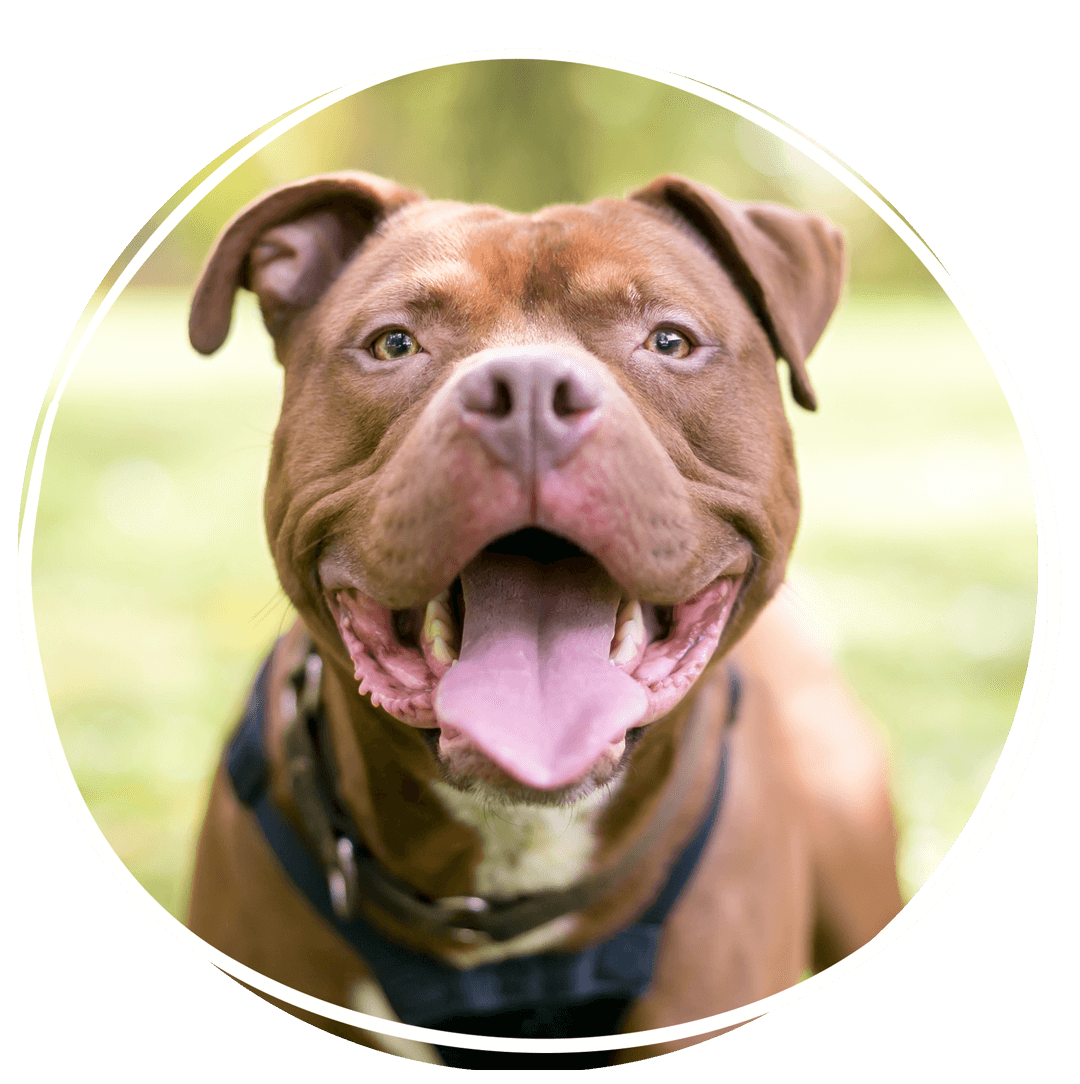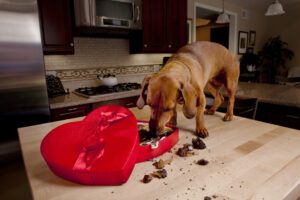
Our Veterinary Blog
My Dog Ate Chocolate. What Do I Do?
Chocolate is a wonderful treat that us humans cannot get enough of. However, chocolate is toxic to dogs, and if you keep it in the house, you must be sure that it is well out of your pup’s reach.
If your dog should happen to get into your chocolate stash, you need to take quick action. Do not wait for symptoms to appear. Either get your dog to an emergency vet, take them to their regular vet, or contact a poison hotline immediately. (ASPCA Poison Control 888-426-4435)
The factors involved in determining the extent of the problem include your dog’s weight and what kind of chocolate they ate. As a typical rule, the darker the chocolate, the more toxic it is for your pup. There are certain compounds in chocolate that makes it toxic for dogs. Read on to learn more about what to do if your dog ate chocolate.

Toxic Ingredients in Chocolate
Chocolate contains two compounds that make it poisonous to dogs. These include theobromine and caffeine. These compounds are safe for humans, as theobromine is in chocolate and caffeine is present in beverages such as coffee. However, these substances are not safe for dogs.
Theobromine
Theobromine is toxic to dogs because they cannot metabolize it as quickly as humans can. It accumulates in their system instead of rapidly processing, producing chocolate toxicity. Theobromine can be used as a vasodilator, a diuretic, and a heart stimulant. It can be helpful for humans in combating fatigue and hypotension.
Caffeine
Caffeine is also bad for dogs because their bodies cannot metabolize it quickly. Caffeine functions by stimulating the central nervous system, heart, and muscles, and it also raises blood pressure. For humans, it is a cognitive enhancer, and it helps with focus and energy. Most people cannot get through the day without their morning cup of joe. Dogs, however, need to steer clear of it because of its toxicity.
The Chocolate Scale 
The darker the chocolate, the extra theobromine it will include. The more theobromine in the chocolate, the more toxic it is for dogs. The following explains the amount of theobromine in each type of chocolate:
- White Chocolate – has the lowest levels of theobromine but can still be harmful to dogs. White chocolate only has 0.25 mg of theobromine per ounce.
- Milk Chocolate – is somewhere in the middle, with 44 mg of theobromine per ounce.
- Dark Chocolate – is higher and contains 179 mg per ounce.
- Baking Chocolate – comes in second place with 390 mg of theobromine per ounce.
- Cocoa Powder – literally takes the cake with 2060 mg per 3.53 ounces.
The darker the chocolate, the more chance there is of a severe reaction occurring; it can even be lethal. Regardless of the amount of theobromine in chocolate, none of it is suitable for dogs. Any chocolate eaten in large enough amounts is dangerous for your pup.
What Are the Indications of Chocolate Toxicity in Dogs?
The symptoms of chocolate toxicity in dogs depend on your pup’s weight, the chocolate type, and how much your dog consumes. Pups typically demonstrate symptoms between four to twenty-four hours after the chocolate is ingested. The following include symptoms:
- Vomiting
- Diarrhea
- Excessive thirst
- Excessive urination
- Panting
- Restlessness
Symptoms may progress to hyperactivity and elevated heart rate. In the worst-case scenarios, symptoms may include muscle tremors, seizures, and heart failure.
 What Should You Do if Your Canine Eats Chocolate
What Should You Do if Your Canine Eats Chocolate
Make sure you take away any chocolate your dog may be able to get into and get it away from them. If you believe your dog has had chocolate, call the Pet Poison Hotline or your veterinarian, or take them to the emergency vet. If your dog had a toxic amount, your pup needs to be examined immediately.
What is the Treatment for Chocolate Toxicity?
The sooner your dog gets treated, the better the prognosis. If toxicity is treated early, vomiting may be induced with charcoal to prevent absorption and move the toxins out of the body without them being absorbed into the bloodstream.
Charcoal may be administered every four to six hours for the first twenty-four hours to decrease the reabsorption and recirculation of theobromine. Supportive treatment may include intravenous fluid therapy to assist with stabilization and flush the toxins through the system faster. Dogs who are experiencing seizures may need to be monitored overnight.
How To Keep Your Dog from Consuming Chocolate
You should never allow your dog to have chocolate, not even a small amount as a treat. Even a little bit of chocolate can be detrimental to your pup’s health. Older dogs and pups with heart disorders are more at risk for abrupt death from chocolate poisoning than other dogs. To keep your dog from getting into your chocolate, try the following tips:
Hide it Well
The best way to keep your dog from getting into your chocolate is to keep all your candies and packaged chocolates somewhere your dog cannot get to, such as on a high shelf or kitchen pantry. Do not leave your chocolate on the countertops or kitchen table. It is good pet parenting to take all the necessary steps to protect your precious pooch from exposure to toxins.
Keep Holidays Safe for Your Dog
The holidays are the time for get-togethers, and everybody loves chocolate. People bring them to gatherings or give them as gifts. Ensure you let children and other adults know not to feed your dog any chocolate. Keep trick-or-treat bags out of reach during Halloween, and do not leave the fancy box of chocolates out during Christmas or Valentine’s Day.
Teach Them the “Leave it” Command
Your dog needs to know that not everything that falls onto the ground is safe for them to snatch up. You may be baking a batch of chocolate chip cookies, and a very tempting chocolate chip falls to the ground. Your dog sees it and gets excited, just asking to eat it up.
Your pup needs to be taught the “leave it” command to ensure they do not go for the tasty morsel. The main goal of the leave-it commands is to teach your pup to leave the item on the floor without being asked. It may take time for them to learn, so be patient with them.
Crate Train Your Dog
The best way to ensure that your pup does not get into anything that could harm them while they are unsupervised is to crate-train them. Make sure the crate is appropriate for their size, and make it a safe, comfortable place for your pup to chill out. Offer them a blanket, some water, and treats. Put their favorite toys, food puzzles, or KONG toy in there, and they will be sure to love them.
Conclusion 
Chocolate is not safe for canines in any amount or type, and you need to make an effort to ensure it is out their paw’s reach if you are going to keep it in the house. If your pup does end up consuming chocolate, do not hesitate to contact your veterinarian or take them to the emergency vet for immediate treatment, as it is better to be safe than sorry.
For pet parents in the Plant City, FL area, Plant City Animal Hospital is here to care for you and your pup. Reach out to us at (813) 752-3073 or make an appointment online today!
Recent Posts
About Us
Family is family, whether it has two legs or four. At Plant City Animal Hospital, we've spent the last 40 years healing and caring for your pets. As a family-operated practice, we know that family is about more than simply being related. Animals give us the ability to develop strong bonds and feel great compassion for a fellow living creature.


 What Should You Do if Your Canine Eats Chocolate
What Should You Do if Your Canine Eats Chocolate